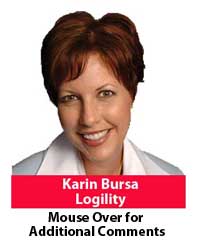Last week, we ran part 1 of our "virtual panel" of supply chain planning experts, wo looked at several key trends and issues relative planning technology and practice. (See Trends and Insights on Supply Chain Planning.)
We're back here this week with part 2 to close out the excellent discussiom.
Once again, are panelists are:
David Johnston, Senior Vice President for Supply Chain at JDA Software
Karin Bursa, Vice President of Marketing at Logility
John Bermudez, Vice President of Product Management at Infor
Lisa Kustra, Founder, Plan4Demand
Mark David, Vice President of Solution Management for Supply Chain Planning at SAP
SCDigest Says: |
 Kustra says that "planning tools are initially implemented in a way where they may just be replacing the current legacy functionality with the goal of optimization later. In many cases the optimization capability is never adopted." Kustra says that "planning tools are initially implemented in a way where they may just be replacing the current legacy functionality with the goal of optimization later. In many cases the optimization capability is never adopted."

Click Here to See Reader Feedback
|
Plan4Demand is a consulting firm focused on supply chain planning. All the other companies are providers of supply chain planning software, also sometimes referred to as Advanced Planning Systems (APS). The participants were selected by SCDigest for their known expertise in this area.
The first question we wanted to explore related to in what areas planning software companies are investing their R&D dollars.
Infor's Bermudez has his company sees opportunities in better S&OP/Integrated Business Planning tools.
"We want to ensure that management has the tools to direct the business through precise integrated planning applications, not just react to the disconnected plans that are not synchronized to achieve the desired business results," he says, adding that "The newest version of our IBP solution also incorporates social networking and event management to provide a simple but rich environment for real-time collaboration across all parts of the organization."
He adds that more broadly, Infor is investing in mobile applications, cloud applications, social business applications and a consumer-grade user experience "delivered in an event-driven internet architecture."
Logility's Bursa says her company is "focused on helping companies have a clearer picture through better data, more comprehensive models and increased flexibility in comparing multiple plans and business scenarios. Our investments center on better analytics, S&OP, and optimization of demand, inventory, supply and transportation."
She notes that just recently Logility released its Proportional Profile Planning software. The solution allows customers to better forecast demand for "sub-SKU" items based on product attributes (like style, color, size, configuration), market factors and stage of life cycle. Typically, organizations have difficulty improving forecast accuracy at the sub-SKU level and streamlining the demand-supply translation, Bursa says (Note: this solution was a recent Supply Chain Digest "Cool New Product of the Month.")
Johnston of JDA says they are putting their R&D spend in such areas as tools for better management and execution of "segmented" supply chain strategies and digitally connecting supply chains across enterprises to take significant cost and cycle time out of the end-to-end supply chain."
 He adds that JDA sees great promise in "Advanced pattern recognition, clustering and analytics that can scale to leverage all sources of insights and data and therefore make more advanced automated decisions." He adds that JDA sees great promise in "Advanced pattern recognition, clustering and analytics that can scale to leverage all sources of insights and data and therefore make more advanced automated decisions."
SAP's David adds that "We see the need to understand a full picture of demand through traditional and non-traditional demand signals. This will include inputs such as web, social sentiments, and market research data, and making this data available to support planning processes. The area of Demand Sensing has become a hot topic, but where you get true business value is in Demand Response. So tying Demand Sensing into solutions where you can respond quickly and efficiently has high potential."
He also sees excellent potential for "in-memory" planning solutions that can dramatically reducing processing times and make new decision support tools available at the same time.
You will be able to see "information about your supply chain in real-time, with decisions and trade-offs done in full context. We see new solutions where could, as an example, combine supply information with market commodity pricing data to make a different type of supply decision, requiring processing of massive amounts of data in real-time."
Consultant Kustra from Plan4Demand also sees a lot of vendor investment in S&OP tools.
 "Vendors are investing in S&OP. It is a simple process that really gets complicated because of poor access to real time data, individual silo mentalities, a poor understanding of the value of planning as a discipline in the company, and lack of executive vision and sponsorship at times," she says. "Vendors are investing in S&OP. It is a simple process that really gets complicated because of poor access to real time data, individual silo mentalities, a poor understanding of the value of planning as a discipline in the company, and lack of executive vision and sponsorship at times," she says.
How Strong is the Current Market for Planning Solutions?
Of course, more R&D will come if the market for planning and related solutions is healthy. Is it right now?
Bursa says many businesses are still conservative when it comes to investment overall, but nevertheless spending on supply chain planning to lower operating costs.
"Many companies are reporting positive growth and returning to profitability but are still cautious of what the next 18 to 24 months will bring" she says. "We see companies turning to supply chain investments as they work to control costs and improve service levels."
Kustra says the market has certainly gotten better, but as a result of all the changes, companies are reconsidering their staffing needs.
"The market is better than it has been in years, even though we have a few more years to recover from the Great Recession," she says. "While companies are trying to hire, there are not enough people with the proper skills in the market are to meet demand. The market needs more analysts, problem solvers, and innovators and not as many worker bees today."
(Supply Chain Trends and Issues Article - Continued Below)
|